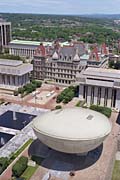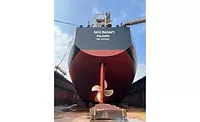Recoating 'The Egg'

Many factors can shorten the lifetime of a roof, including UV rays, freeze-thaw cycles, wind, rain, biological growth, chemical reactions with air pollutants, temperature changes and poor installation.
Over the last few years, because the types of roof coatings used to protect against these elements have improved, more people are opting to coat their roof rather than build a new one. Among the different coatings available on the market today are acrylic, bituminous, polymeric, polymer modified and elastomeric roof coatings such as styrene-ethylene/butylene-styrene (SEBS) coatings. SEBS coatings made with KRATON(r) polymers, can protect against a number of risks, including the prevention of leaks and moisture penetration.
For example, one of the most high-profile buildings in Albany, NY, is the Performing Arts Center, otherwise known as "The Egg" for its oval shape. It is a sculpture that sits in the thriving art district. This landmark is located in the Empire State Plaza under the watchful eye of two of the state's most important government bodies - the capitol is on one end of the plaza and the governor's mansion on the other. So, in early 2002 when it was time to recoat the roof, the New York Office of General Services (OGS), Design and Construction, turned to experts to keep The Egg functional and white.
The previous coating was Hypalon, or chlorosulfonated polyethylene (CSPE). The Hypalon was getting thin as it aged, and it was chalking due to the chemical used to prevent algae growth.
"I wanted something that was heavier-bodied this time," said John Morelli, assistant architect with the State of New York OGS, Design and Construction.
The OGS office opted to use a coating from Truco Inc. This wasn't the first time they had used Truco. In 2000, when the State Education Building in Albany needed the roof restored, Rick Franklin, a Truco representative, suggested using its Eterna-Seal product in patina green to coat the copper panel roof. Because of the company's 10-year warranty and a good experience with the coating, it was a natural fit to use a similar product from Truco to coat The Egg.
Eterna-Seal is an elastomeric coating that uses SEBS styrenic block copolymers (SBCs) as its main resin. Truco has relied on SEBS from KRATON Polymers for more than 20 years. In SBCs, part of the molecule is polystyrene, which is hard, and part is rubber, which is elastic. When SBCs are mixed with other substances, such as in the Eterna-Seal coating, the resulting compounds take on these characteristics. The coating forms a tough but pliable "rubber blanket" that goes over the entire roof's surface and is able to expand in hot weather and contract in the winter. It also provides extra-thick protection over vulnerable areas like seams, fasteners, curbs and penetrations, thus preserving the tightness of the seal. Additionally, SEBS adds strength, making the coating resistant to scuffing and cracking.
Because this coating was going to be used as a top layer, it also needed something stable and resistant to UV degradation. SEBS resin formulations, when properly formulated, can reflect over 80% of the UV rays. This makes the product ideal for the Energy Star(r) program, a voluntary program sponsored by the U.S. Department of Energy (DOE) and the EPA, which strives to increase consumer awareness, interest, and desire for energy efficient products. Energy Star-labeled roof products can lower roof surface temperature by up to 100 deg F, thereby decreasing the amount of heat transferred into a building's interior and saving money and energy by reducing the amount of air conditioning needed to keep a building comfortable.
According to a study performed by the Roof Coatings Manufacturers Association (RCMA) and the Oak Ridge National Laboratory, on a sunny day, uncoated surfaces can reach up to nearly 100 degF above ambient temperature while smooth surfaces with white coatings only heat up about 10-20 deg above ambient temperature.
Elastomeric coatings also have low moisture permeability, which is measured in perms; Eterna-Seal has about 0.2 perms, allowing it to protect against algae and fungi, and keep its durable bond on substrates subject to ponding water. Most importantly, SEBS coatings provide excellent adhesion, which ensures the long-term sustainability of the substrate.
Truco is no novice when it comes to coating over Hypalon; they have been doing it for nearly 15 years. "We have a reputation for being a conservative company," says Hoskins. "Before we sell a product, we test it in the lab and then on smaller roofs for about five to seven years. We also have done a project like this single-ply Hypalon roof, 10 years ago at the Dulles International Airport, so we had the experience needed to do a good job."
Before the roofers could begin the coating process, the roof had to be prepared. One of the requirements for the Truco coating is a dry roof. An infrared scan, which measures the temperature, was used to determine if there was moisture on the roof. Moisture can disrupt the coating and cause bubbles to form. Once the dryness of the roof was confirmed, the workers refastened the plywood and patched up some areas of the membrane. Next, they washed the roof and set up the safety systems. The roofers were careful not to over-wash the roof to avoid moisture penetration. Once preparations were complete, the coating was applied.
The actual coating process was a bit complicated. Because of the building's unique shape, it is about 80-90 feet from the low part to the plaza. The roofers had to attach a five-inch steel cable, lanyards and body harnesses to nine anchor points on the roof so that everyone would be tied up all of the time. Only five workers were allowed on the roof at any one time.
Two coats of Eterna-Seal 7140 were sprayed onto The Egg using a Titan 8900 300-spi haudralic sprayer. This solvent-based formula has extremely high tensile strength and elongation properties. It is also wash-off-resistant, which gives workers the ability to apply the coating for more months during the year. Workers also don't have to worry about the rain washing off the coating once it has been applied.
After three months, the coating was complete. "Everyone here is very happy with how good it looks, how quickly it was completed, and how easily the project went," said Morelli. "The surface is bright white with a very even texture. I was up on the roof right after it was completed, and was impressed by how good it looked. It helped that we had a very good team of experts."
For more information, e-mail info@KRATON.com or visit www.KRATON.com.
Looking for a reprint of this article?
From high-res PDFs to custom plaques, order your copy today!






